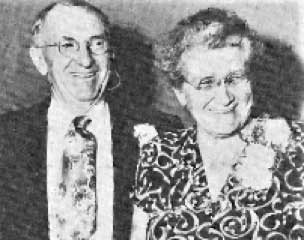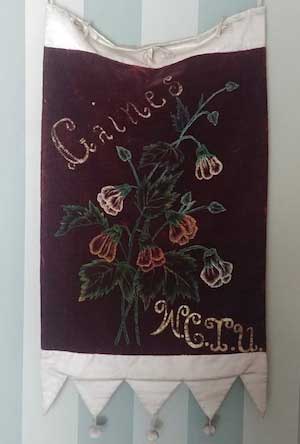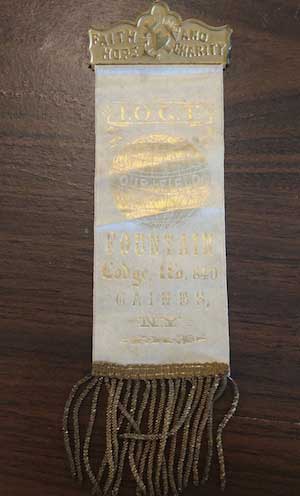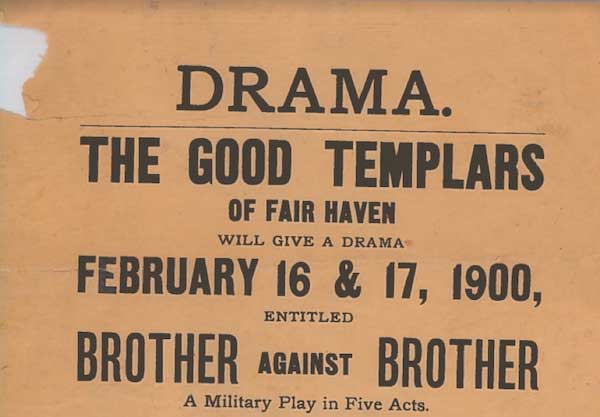Historic Childs: Gaines community embraced temperance, fought alcohol consumption
By Freeman Lattin, Cobblestone Museum intern

Joseph and Nellie Vagg are pictured here on their 45th wedding anniversary in 1948. The Vaggs were lifelong residents of Childs and pillars of the community.
(Editor’s Note: This is the fifth article in a series about historic Childs in the Town of Gaines. The hamlet of Childs lies just north of Albion at the intersection of Routes 104 and 98. In 2019, Childs was selected to be on the Landmark Society of Western New York’s “Five to Revive” list. In 1993, the federal U.S. Department of the Interior declared the Cobblestone Museum in Childs a National Historic Landmark, the first site in Orleans County with that distinction. The NYS Barge Canal was later declared a National Historic Landmark in 2017.)
GAINES – Although Childs today maintains much of its small hamlet charm, it has never been immune to the economic, technological, or social changes of America. The country, the county, and Childs itself have changed immensely since John Proctor first settled here.
One thread of American history that Childs (or Fair Haven) was wrapped up in was the temperance movement. Beginning in the 1870s and peaking in popularity around the time of Prohibition, the second wave temperance movement in America was an attempt to reform society by doing away with the supposedly corrupting influence of alcohol.

Nellie Vagg would have been a member of the Gaines chapter of the WCTU. This banner hangs in the Ward House at the Cobblestone Museum in Childs.
The crowning achievement of the temperance movement was undoubtedly the 18th amendment, or Prohibition, which was ratified in 1919. Of course, even though the government had made the sale of alcohol illegal, it was definitely still consumed in Childs and in speakeasies across the country.
It was said that during the prohibition years, just as many customers stumbled out of the Village Inn as they had before. This was much to the chagrin of Mrs. Nellie Vagg, a staunch temperance advocate who lived on the corner of routes 104 and 98.
As a lifelong member of the Gaines chapter of the Women’s Christian Temperance Movement, Nellie had a deep aversion to the consumption and sale of alcohol. The WCTU was an organization formed in 1874 with the goal of creating a “sober and pure world.” Although the group pushed for other reforms such as the abolition of tobacco and labor protections, its chief goal was the prohibition of alcohol.

This ribbon is from the I.O.G.T. hall at Fair Haven (now Childs).
Nellie was deeply devoted to the cause of temperance, and she always wore the WCTU’s signature white ribbon which was a symbol of purity and abstinence from alcohol. Mrs. Vagg is a great example of how staunch many temperance advocates were in that era. As Erin Anheier, Cobblestone Museum president, mentioned in last week’s article on the Vaggs, Nellie was very prominent in the local temperance movement and even served as a delegate to the statewide WCTU convention.
The other pillar of the temperance movement in Childs were the Good Templars. The International Order of Good Templars was a fraternal group founded in 1851 to promote temperance and total abstinence from alcohol and drug use.
In contrast with the WCTU, the Good Templars were a traditional fraternal organization based on Freemasonry, so they had a greater focus on rituals, ceremonies, and regalia. Their building was located across from the Village Inn, two houses away from the Vagg property.
Being situated across from the main watering hole in Childs, the Good Templars took it upon themselves to put on small “home talent” plays to provide the community with wholesome entertainment and an alternative to the boozing that took place across the road.
Today in Childs, you can still buy a drink at the Village Inn or a six pack at Crosby’s, so it’s obvious that booze has outlasted its most vocal detractors. The temperance movement in Childs, like the rest of the country, fizzled out with the repeal of prohibition and never regained its former prominence.

Pictured here is Norris Vagg, the son of Joseph and Nellie, and the Good Templars’ meeting hall in the background. Unfortunately this is the only known picture of the building.

This advertisement is an example of the wholesome home spun entertainment the Good Templars put on in Childs. Admission to this play cost 10 cents, or 15 cents for reserved seats.





























































